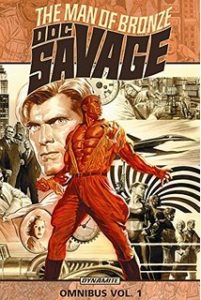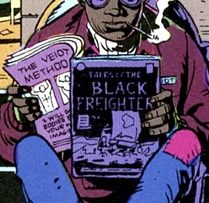 Watchmen by Alan Moore and Dave Gibbons is a metacomic, a comic about comics, in several ways. First of all, the book challenges our understanding of comics because it includes sections of straight text between every colorful chapter: excerpts from an autobiography, a police file, an article from an Ornithological journal, an editorial from a right-wing magazine, pages from a scrapbook, business correspondence, and so on. Watchmen is, in fact, a postmodern compendium of texts, yet it is still principally a comic (or a graphic novel if you prefer).
Watchmen by Alan Moore and Dave Gibbons is a metacomic, a comic about comics, in several ways. First of all, the book challenges our understanding of comics because it includes sections of straight text between every colorful chapter: excerpts from an autobiography, a police file, an article from an Ornithological journal, an editorial from a right-wing magazine, pages from a scrapbook, business correspondence, and so on. Watchmen is, in fact, a postmodern compendium of texts, yet it is still principally a comic (or a graphic novel if you prefer).
 Most importantly, Watchmen is a comic about comics. In an extract from the autobiography Under the Hood, Hollis Mason (the first Nite Owl), gives a brief history of superhero comics, tracing their lineage back to the pulp adventure fiction of Doc Savage and The Shadow. “The world of Doc Savage and The Shadow,” Mason writes, “was one of absolute values, where what was good was never in the slightest doubt and where what was evil inevitably suffered some fitting punishment.” Mason speaks of the simple morality of those pulp fiction tales with longing, for the morality of his world, the morality of Watchmen, is messy and confusing. (For example, the Silk Spectre loves the Comedian, a man who tried to rape her, breaking several ribs.) “For my part, all those brilliant and resourceful sleuths and heroes offered a glimpse of a perfect world where morality worked the way it was meant to,” Mason says, and then challenges his readers, “Which world would you rather live in, if you had the choice?”
Most importantly, Watchmen is a comic about comics. In an extract from the autobiography Under the Hood, Hollis Mason (the first Nite Owl), gives a brief history of superhero comics, tracing their lineage back to the pulp adventure fiction of Doc Savage and The Shadow. “The world of Doc Savage and The Shadow,” Mason writes, “was one of absolute values, where what was good was never in the slightest doubt and where what was evil inevitably suffered some fitting punishment.” Mason speaks of the simple morality of those pulp fiction tales with longing, for the morality of his world, the morality of Watchmen, is messy and confusing. (For example, the Silk Spectre loves the Comedian, a man who tried to rape her, breaking several ribs.) “For my part, all those brilliant and resourceful sleuths and heroes offered a glimpse of a perfect world where morality worked the way it was meant to,” Mason says, and then challenges his readers, “Which world would you rather live in, if you had the choice?”
 Mason goes on to explain that in 1938 the first issue of Action Comics came out. The magazine was a collection of “detective yarns and stories about magicians whose names I can’t remember,” Mason tells us, “but from the moment I set eyes on it I only had eyes for the Superman story.” The first superhero’s world was a world of simple morality: “Here was something that presented the basic morality of the pulps without all their darkness and ambiguity. The atmosphere of the horrific and faintly sinister that hung around the Shadow was nowhere to be seen in the bright primary colors of Superman’s world, and there was no hint of the repressed sex-urge which had sometimes been apparent in the pulps.”
Mason goes on to explain that in 1938 the first issue of Action Comics came out. The magazine was a collection of “detective yarns and stories about magicians whose names I can’t remember,” Mason tells us, “but from the moment I set eyes on it I only had eyes for the Superman story.” The first superhero’s world was a world of simple morality: “Here was something that presented the basic morality of the pulps without all their darkness and ambiguity. The atmosphere of the horrific and faintly sinister that hung around the Shadow was nowhere to be seen in the bright primary colors of Superman’s world, and there was no hint of the repressed sex-urge which had sometimes been apparent in the pulps.”
So far, the history that Mason is sharing is an accurate account of the development of superhero comics, but at this point Watchmen veers away into alternative history, for masked adventurers begin to step out into the real world. Someone with a black hood over his head and a noose around his neck performing vigilante activities begins to appear in the news. The press soon dub him Hooded Justice. Mason realizes that he too can become masked adventurer: “I dressed up as an owl and fought crime because it was fun and because it needed doing and because I goddam felt like it.” Soon, heroes start popping up all over the place and masked vigilantism becomes all the rage.
What happens when real people play out superhero fantasies? Ironically, the sloppy morality of these real world vigilantes undermines the popularity of superhero comics. Comics about pirates become more popular than superhero comics.
 Throughout Watchmen, we read sections of a pirate comic, Tales of the Black Freighter, over the shoulder of a black boy who sits at a newsstand. This comic within a comic is an example of a mise en abyme. The term, coined by Andre Gide, refers to a book within a book, or a painting in a painting, a photo in a photo. The mise en abyme is the best means of understanding the larger work. “Nothing,” Gide argues “sheds more light on the work or displays the proportions of the whole work more accurately.” (Read more about mise en abyme in my post “The Mirror in the Text Part II: Mise en Abyme.”)
Throughout Watchmen, we read sections of a pirate comic, Tales of the Black Freighter, over the shoulder of a black boy who sits at a newsstand. This comic within a comic is an example of a mise en abyme. The term, coined by Andre Gide, refers to a book within a book, or a painting in a painting, a photo in a photo. The mise en abyme is the best means of understanding the larger work. “Nothing,” Gide argues “sheds more light on the work or displays the proportions of the whole work more accurately.” (Read more about mise en abyme in my post “The Mirror in the Text Part II: Mise en Abyme.”)
In fact, the comic within the comic echoes the language, images and events taking place in the real world. The first excerpt we read from Tales of the Black Freighter says, “Delirious, I saw the hell-bound ship’s black sails against the yellow indies sky, and knew again the stench of powder, and men’s brains, and war.” The excerpt appears without explanation over a closeup of a black and yellow fallout shelter sign (matching the black sail and the yellow sky of the comic within the comic). The news vendor says to the reading boy (who is not paying attention), “We oughta nuke Russia and let God sort it out.” The threat of war is as central to Watchmen as it is to Tales of the Black Freighter. The comic within the comic informs and comments on the events taking place in Watchmen.
In fact, the comic within the comic helps the reader to make sense of the enigmatic ending of Watchmen. In Tales of the Black Freighter, the shipwrecked hero builds a raft but must buoy it up with corpses with bloated stomachs, he eats gulls raw, and resorts to murder as he races home to save his family from the Black Freighter. As time passes, he realizes he will arrive too late and his family will be dead and his home occupied. When he finally enters his house in the dark, he attacks a usurper, bludgeoning the person to death. Two children appear in the doorway and he realizes they are his children and he has just killed his wife. Rather than appearing too late to save his family, he has arrived before the black freighter. He has in fact become the villain that he wanted to protect his family from. He flees his home and murdered wife and makes his way to the dark shore, asking himself, “How had I reached this appalling position, with love, only love, as my guide?” He sees the black freighter coming towards him across the water. “The world I’d tried to save was lost beyond recall. I was a horror: amongst horrors must I dwell. A rope snaked down, muttering, I grabbed it.”
(Spoiler warning) Like the hero of Tales of the Black Freighter, Watchmen ends in a mess of moral complications. Adrian Veidt, known as Ozymandias, has pulled the world back from the brink of nuclear war, by letting loose a giant, genetically engineered monster on New York, killing millions. In the face of this common enemy (a simple, easy to understand, comic-book monster), the world unites and enters a period of peace, but in the process Ozymandias has become the threat he was protecting the world from. The hero has become the villain. People very rarely do evil with the intention of doing evil. The great crimes of humanity have been committed in the name of heroism, with the intention of doing good. Think of Hitler, Stalin, and Pol Pot.
No wonder then that we close the book with a twinge of dissatisfaction. Nothing is resolved as it should have been. Veidt is not punished. War is averted, but millions lie dead in New York. Where, we wonder, have the bright primary colors and simple of morality of superman comics gone? Thinking of superman’s world and the world of Watchmen, we may ask like the Nite Owl, “Which world would you rather live in, if you had the choice?” Well, we may want to live in Superman’s clean and colorful world, but we do not. We live, in a messy world of jumbled texts and muddy morality. And the feeling of dissatisfaction with which we close the graphic novel grudgingly becomes one of admiration. Watchmen, a metacomic, is a masterpiece of literature.
(To read more about this great book, check out “Watchmen: The Moment Comic Books Grew Up” by Nicholas Barber from BBC.)


One thought on “Watchmen: A Metacomic”